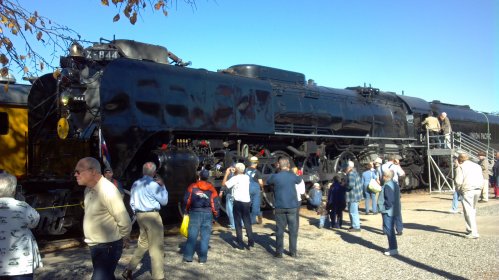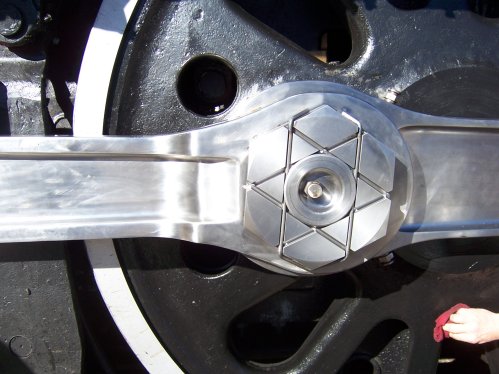
It’s Halloween! Eggnog is in stock! Yes, today was the first day that Farm Crest’s almost unsurpassed eggnog goes on sale at the Farm Crest milk stores owned by (I kid you not) Pester Marketing. (Their eggnog is surpassed only, I think, by Oberweis in Chicago.) Stock up now; Christmas is only two months away!
Mmmph. Maybe next month. I bought a gallon of high-fat milk instead. I may not be the 5%, but I sure as hell drink it. On the way, I stopped near the old downtown Colorado Springs train station on Sierra Madre to see the Union Pacific #844 Niagara steam loco, which is on tour and in town for yesterday and today only. #844 was the last steam loco ordered by UP, and it’s been lovingly restored as a sort of rolling, steaming, hot-and-dripping museum. I don’t see 4-8-4’s very often, and never before a live one, so it was well worth the detour. Smaller cities are great in that I scored a parking place right across the street, and could get photos with almost nobody else in the way. I doubt I would have done that well in, say, Chicago.

It’s tough to get size perspective on machines like this. The eight drive wheels are eighty inches in diameter, and the engine as a whole is 114 feet long. Because of a historical quirk, “standard” railroad gauge is four feet eight inches, meaning that the wheels are considerably wider than the gap between the rails. I always wonder, facing a behemoth like this, how they managed to keep it on the tracks. (One answer is luck. Another, gravity. Most of all, skill. Alas, sometimes the answer is, They didn’t.)
There were a number of people swarming the loco, polishing the connecting rods and valve gear and wiping dirt off the painted parts. It was surreal how shiny the metal bits were–I would guess it wasn’t anything like this clean back when it was earning a living. In fact, while I was admiring the dazzlingly burnished iron, a young mother walked over with a three-year-old on one hip. As she turned around to pose for dad’s camera, the small boy reached his hand out to the connecting rod. His mom jerked him away: “Danny, don’t touch that! You’ll get it dirty!”

Some time tomorrow morning, old #844 will head south on the BNSF main line to Pueblo. Given that we look down Cheyenne Mountain toward the tracks and hear the Diesel horns on the BNSF coal trains all the time from our back deck, there’s a nonzero chance that I may hear the 844’s transplanted Big Boy whistle as the consist roars by. I’m sure going to try: The weather will be decent and I may never get another chance to hear any steam locomotive–much less a Niagara!–roar past my house.
As for Halloween itself, well, the Kid Gods are delivering near-perfection this year in Colorado Springs: 68 windless degrees under a cloudless sky. The legendary Halloween of 1964 was something like this in Chicago, and better only because it was on a Saturday. I’m not expecting a lot of traffic this year, since small children are scarce in this neighborhood of retired lieutenant colonels. I did buy a bag of Smarties for the big bowl by the front door, intrigued by the presence of dextrose as the sole sugar. I’ve never seen dextrose explicitly called out in a list of incredients before, even on candy. It’s typically “sugar” (generally sucrose, which is half fructose) or “high-fructose corn syrup.” I wonder if the animus against fructose has become so great that manufacturers are leaving nothing to supposition. If so, it’s a quiet victory–and not a small one.
Finally, QBit and I watched Van Helsing last night on the Family Channel. (Carol is still in Chicago and the rest of the Pack at Jimi’s.) The film is a great, whacky over-the-top paean to Victorian monsterabilia. Lessee: Wolfman, Dracula, Dr. Jeckyll and Mr. Hyde, miscellaneous vampires, plus Dr. Frankenstein, Igor, and the Monster. (The Mummy was indisposed.) Oh, and what I consider the single most dazzling steampunk movie weapon of all time: An automatic-fire crossbow that spits bolts at flying vapiresses as long as you hold the trigger. Dip the front end in a holy water font and you are da bomb! (And if you miss, just flick a fingerful of gooey glycerin-48…)











Ok, train aficionados, here’s a train trivia puzzle for your enjoyment. If you know the answer please don’t spoil it for everyone else.
When a train is moving most parts are moving in the same forward direction of motion relative to the ground but one part actually moves backwards. What is it?
I would say the tie rods that connect the pistons to the wheels.
Jim, It’s not the tie rods. They’re offset from the axle which gives them leverage so the faster they move the faster the wheel spins and the faster the train moves forward. For them to move backwards the wheel would have to break traction and spin on the track. Good thinking, though.
Trains in general, or just steam trains?
Bruce, it’s true for all trains.
The inside edge of the wheel at the moment it is below the rail contact surface. The wheel is tapered, and the inside edge hangs below the rail a bit. I remember this from my O scale model railroading days, although I’m not sure why.
If you want to be picky, the inside edge is moving backward with respect to the (rest of) the train, but with respect to the ground it is merely moving forward at a slower rate.
(Yeah, I know, but I majored in physics in college, and this kind of nit-picky stuff can be important when solving problems in ‘mechanics’.)
Rich, that’s it! The wheel flange extends below the contact point of the wheel and rail. The contact point itself is motionless and the flange moves backwards relative to the ground.
Ok. I’ll cop to the fact that I didn’t get this one. I think I know why: Our mentally distilled images of complicated artifacts simplifies their structure, and in trying to envision the complex motion of #844’s machinery, I simplified the flanges right off its wheels, even though the flanges are utterly fundamental to the operation of railroads.
Wonderful brain teaser.
Jeff, you have some smart friends here. Hardly anyone gets that brain teaser.
You asked about what keeps a train on the rails and that’s a good brain teaser too. The flange isn’t the primary reason. It’s there just for safety and in principle when things are in good working order it should never come in contact with the rail. Two bigger factors are the taper of the wheels (they aren’t flat) that continuously pressure them to recenter and the cant of the rails (where the outside rail on a curve is elevated.)
There’s more information here if you’re curious:
http://en.wikipedia.org/wiki/Rail_adhesion#Directional_stability_and_hunting_instability
> mental simplication
This is one of those two-edge swords. We can’t accomplish anything meaningful if we’re so mired in the tiniest details that we can’t make progress. At the same time, we can’t accomplish anything meaningful without being mindful of the tiniest details. The ability to walk up and down the tree of abstraction is an important mental skill.
The way I map out these teasers is to sometimes exaggerate the geometry. Imagine a flanged wheel on a rail poised in free space, with a flange diameter hugely out of proportion with the contact surface diameter. Then roll it forward, and watch it in your mind’s eye. Well, it works for me, anyway.
Victorian monsterabilia…
No, early Hollywood monsterabilia. True, Dracula and Jekyll/Hyde were conceived in the Victorian era, but the common conception of Dracula (the urbane, lethal charmer) was invented in the 1931 movie. Frankenstein and his creature are pre-Victorian, but again, the modern conception (including Igor, AFAIK), also dates from the 1931 movie.
“Wolfman” is interesting. Google Ngrams shows “werewolf” popping into English usage circa 1860 (in a big way), and hanging around ever since. “Wolfman” appears with spikes in 1931 and 1938. “Wolf Man” appears as a spike in 1943 (though the movie came out in 1941). Oddly, “werewolf” also took off about that time, eventually becoming much more common than either of the -man variants ever were.
So while there was, apparently, a mid-Victorian werewolf fad, the “Wolf Man” is 20th century creation. I can’t tell what made the early spikes in “Wolfman”.
There was a story from Hans Christian Andersen called “The Werewolf,” unless I misrecall, and the timeframe is right. Our images are definitely Hollywood (and this includes minor characters like poor Igor) but the concepts (most of which grew out of superstitions and folktales) first hit it bigtime with the expansion of literacy and hence recreational reading in the midlate 19th century.
That said, The Mummy and King Kong were certainly Hollywood creations. (Mummies were big in Victorian circles, albeit not shambling around making trouble.) I half-expected to run into one or more mummies in Van Helsing, but King Kong would have been a stretch.
There were thousands of mummies floating around, and one could buy one quite easily – well into the 20th century. For instance, the “Dr. Thorndyke” mystery Mr Pottermack’s Oversight by R. Austin Freeman (1930).
The protagonist kills a loathsome blackmailer and disposes permanently of the body. Then he meets a long-lost love, and hopes to marry her.
Unfortunately, the lady married the blackmailer, and does not consider herself free while he is presumed alive.
Mr. Pottermack must supply a dead body for the scoundrel. He fakes up a corpse to pass for the dead man (after lying outside for a year or so; the corpse is identified by articles about its person).
Where does he get the corpse? He buys a mummy at an antiques sale.
Insert quote at the top of the preceding:
Mummies were big in Victorian circles, albeit not shambling around making trouble.</i
[…] tweets status updates on the tour of its restored 4-8-4 steam loco, #844, as I described in my entry for October 31, 2011. I have line-of-sight from my house to the BNSF tracks on which #844 would be taken south to Pueblo […]